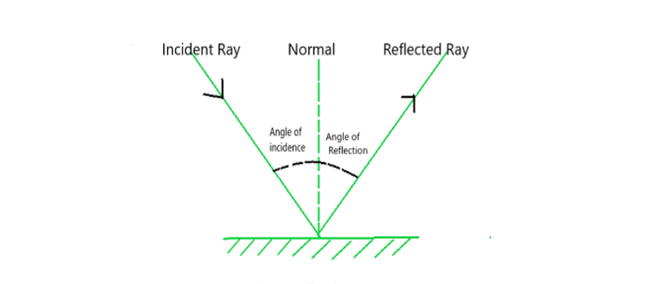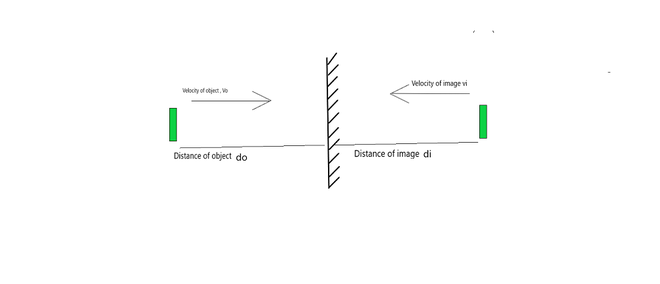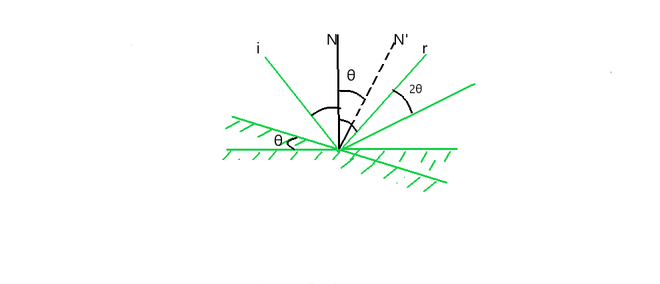平面反射
在开始反射光之前,每当一束光线照射或落在光滑或抛光的表面上并被反击时,就会发生反射。简而言之,接近或撞击任何表面的光线会导致光的反射。接近反射面或从其上入射的光线称为入射光线,撞击后反射回来的光线称为反射光线。如果要在反射面上的入射光线和反射光线之间画一条垂线,则称为法线。
光的反射
从反射表面反射回来的光被称为光的反射。光线遵循某些定律,通过这些定律会发生光的反射。

平面镜上的光反射
反射定律
有两个主要的反射定律:
- 入射角 (∠ i) 等于反射角 (∠ r) 在数学上, (∠ i = ∠ r)。
- 所有三条光线,即入射光线反射光线,以及入射点的法线,都位于同一平面内。
平面镜上的反射
当光线在平面镜上划过并被反射回来时。根据反射定律,入射角等于反射角(∠ i = ∠ r)。出现在镜子中的图像是在平面后面获得的。图像 是 虚拟 的 , 在 本质 上 是 直立 的 , 被 称为平面 镜 的 反射.
平面镜成像的特点
平面镜形成了不同的特征,这些是,
- 通过平面镜形成的图像总是虚拟的(在屏幕上无法获得的图像)和直立的(直立的或直立的)。
- 物体的大小和图像的大小都是相等的。
- 物体放置的距离与获得的图像之间的距离相同。
- 获得横向倒置图像,即物体的右侧出现在镜子后面的左侧。
Real and Virtual Image
Real Image | Virtual Image |
| Real Images are Inverted. | Virtual Image are erect. |
| Real Images are formed on screen. | Virtual images seems to be on the lens or the mirror itself. |
| Real images are formed by concave mirror. | Convex mirror form virtual images. |
| Due to actual intersection of light rays real images are formed. | Due to imaginary intersection of light rays virtual images are formed. |
平面反射
当真实物体在镜子前时
考虑一个真实的物体,例如在平面镜前的蜡烛,现在观察形成的图像,图像是直立的,相同的大小并且在本质上是偏离虚拟的,并且蜡烛与该蜡烛从镜子中形成的图像之间的距离是相等的,所以我们可以说,如果物体是真实的,那么所形成的图像将是虚拟的,直立的并且与物体的大小相同。
当物体靠近或远离平面镜时
现在假设一个人开始将蜡烛移向镜子,然后蜡烛的图像以相同的速度接近镜子,当蜡烛离开镜子时也是如此,图像相对于物体的速度将由下式给出,

物体向镜子移动
Velocity of object = vo
velocity of image = vi = -vo
The relative speed of image with respect to object = vo – vi = vo – (-vo) = 2 vo .
当镜子靠近或远离物体时
如果一个人以速度 v 将镜子移向或远离物体,则图像将以 2v 的速度移向或远离物体。
物体形成一定的角度或偏差
通过反射定律我们知道反射角等于反射角,偏差(∅)定义为入射光线方向和出射光线方向之间的夹角,假设如果入射到表面上的光线角度 i,则偏差为:

Angle of deviation, ∅ = 180 – ( i + r) = 180 – 2i ,
the maximum deviation is occur when angle of incidence is 0°,
∅ max = 180 – 2 × 0 = 180° .
镜子旋转一定角度
考虑放置在离镜子固定位置的物体,如果平面镜旋转角度θ,那么反射光线也旋转角度是旋转平面镜的两倍,即(2θ)。但图像的大小保持不变。

镜子旋转了一定角度
示例问题
问题一:提到平面镜成像的一些特点。
回答:
Some of the characteristics of the image formed by a plane mirror are as:
- Image is always virtual and erect.
- The size of the object and the size of the image both are equal.
- The distance at which the object is placed is the same as the distance between the image obtained.
- The image formed is laterally inverted.
问题 2:如果物体距离平面镜 30 厘米,那么确定图像距离它有多远。
回答:
As we know, the size of the object and the size of the image both are equal in-plane mirrors.
Therefore we have,
The object would be at a distance = 30 + 30 cm = 60 cm from its image.
问题3:如果光线形成的入射角是60 °平面镜,那么反射角应该是多少。
回答:
The angle of incidence = 60°
For plane mirror,
The angle of incidence (∠ i ) = angle of reflection (∠ r ).
Therefore Angle of reflection = 60°.
问题 4:定义术语横向反转。
回答:
Lateral inversion is defined as the reversal of mirror image where the right side of the object appears on the left side behind the mirror.
For example, when a person lifts his left hand in front of the mirror it appears to be right w.r.t to the mirror.
Another example is the word AMBULANCE written over hospital’s ambulance which is inverted written this is because when a driver saw the word in the mirror it inverts back which makes the word readable so that a person give side to the ambulance.
问题5:平面镜旋转θ角时,对像的大小和反射角有什么影响?
回答:
When a mirror is rotated through angle θ, then the angle of reflection becomes 2θ, but there is no effect on the size of the image, the in-plane mirror size of the image is equal to the object.
问题 6:写出真实图像的一些属性。
回答:
Some properties of the Real image are:
- Real Images are Inverted
- Real Images are formed on the screen.
- Real images are formed by the concave mirror.
- Due to the actual intersection of light rays real images are formed.